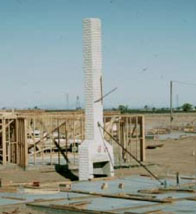
Imagine this scenario: You have spent a great deal of time looking for that perfect home. You did your due diligence. You had the proper home inspections and then made the single most expensive investment of your life. After moving in, you decide to get the chimney inspected and swept. The chimney sweep comes in and, within just a few minutes, has discovered that your chimney is a Rampart General Pre-Cast system. And, because of a major defect, the system can never be used. Because most home inspectors don’t have specific training in this system, they oftentimes don’t recognize the potential issues inherent with this type of chimney.
Unfortunately, this scenario happens all too often.
What is a Rampart General Pre-Cast Chimney?
Rampart General is the name of the manufacturer of the chimney system. Hence the nickname for these systems is “Ramparts.”
Pre-Cast describes how the chimney was made. The system was manufactured in Santa Ana, California from a cast or a mold, with a 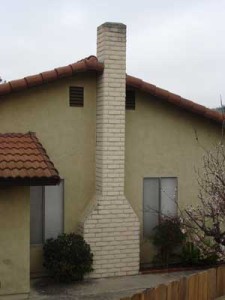 combination of calcium aluminate cement and lightweight aggregate. The cast was cured and then transported to various parts of California.
combination of calcium aluminate cement and lightweight aggregate. The cast was cured and then transported to various parts of California.
At the construction site for the home, a concrete pad was poured. The transport truck simply tilted the chimney into place by using a heavy chain and t-bar down the inside of the chimney. Some chimney professionals refer to these systems as “tilt-ups” for that reason. In some cases, the truck dropped the chimney while placing it on the pad, resulting in damage to the system.
The mold or cast for the chimney structure was designed to make the chimney appear that it was constructed with bricks and mortar. To the untrained eye, the system appears to be a normal masonry system. We have found that some home inspectors who are not familiar with this system will call the system out as a masonry system but in fact, it’s anything but.
How to Identify a Rampart General Pre-Cast System
These systems are located in developments throughout California. Ramparts can be found in homes constructed anywhere from the mid-1960s to the early 1990s.
The chimneys (with few exceptions) will look like an off-white color brick. Some homeowners may think it’s a painted brick but in fact it’s the color of the calcium aluminate cement. If it’s a different color than the off-white, someone has painted the chimney.
The chimneys (with few exceptions) will be located on an exterior wall of the home. That’s because the chimney was tilted up into place.
In many cases, the exterior chimney appears to have a very narrow chimney above the shoulders of the chimney, much narrower than a masonry chimney.
These systems can be found primarily in Southern California as well as throughout California and may be found in other states as well. In San Diego County, we have found patches of them in Imperial Beach, Chula Vista, Paradise Hills, Spring Valley, Lemon Grove, El Cajon, Fletcher Hills, San Carlos, Del Cerro, Santee, Tierrasanta, Scripps Ranch, Mira Mesa, Rancho Penasquitos, San Marcos, Escondido, Oceanside, Encinitas, Carlsbad and Leucadia.
Here’s a local news report about these damaged systems.
Problems with Rampart General Pre-Cast Systems
There are three major irreparable problems with these systems:
Insulation Plate
The primary problem is the potential for having cracks in the insulation plate, also referred to as the breast plate, which is located directly above the opening inside the firebox.
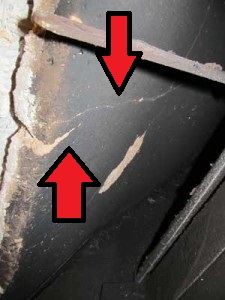
If the insulation plate is cracked, there is no approved repair and the system SHOULD ABSOLUTELY NOT be used due to the high risk of a fire between the chimney structure and the home. Stove inserts (gas, wood, or pellet) or gas logs should not be installed, and there is no approved repair.
In the almost two decades following our training in Rampart General Pre-Cast systems, we have found that approximately 60% of the systems that we have inspected here in San Diego had a cracked insulation plate.
Even hairline cracks in the insulation plate are dangerous because they will widen or expand with heat, and then allow this heat to transfer through the cracks to combustible materials used in construction around the fireplace.
According to Dale Feb of Fireplace Investigation, Research & Education Service, the leading expert in the country for this system, “Based on the manufacturers’ specifications, the ICBO evaluation report and the acceptance by the local building official of these two documents, we are not allowed to deviate from the construction, installation or repair requirements stated within these written details.”
In other words, repairs such as patching, relining, or stove inserts are not viable solutions to repair Rampart General Pre-Cast systems. These chimneys were UL-Listed and approved in their original design and no modifications are permitted. Relining or installing a stove insert would be considered a modification and therefore would not be approved under the UL listing.
Most manufactuers of stove inserts specifically state that they cannot be installed into a fireplace or chimney system that is damaged. This is yet another reason why stove inserts cannot be installed into a Rampart.
No repairs have been approved by the manufacturer or by the Superior and Municipal Courts of California who have made rulings in cases involving Rampart General Pre-Cast systems.
Unfortunately, Rampart General, the company that constructed these chimney systems is now out of business so there is no recourse against the manufacturer.
Cracks in Chimney Structure
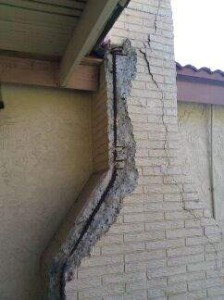 The second issue that we find is the exterior chimney structure will often be cracked as well. These cracks appear as long, deep, wide vertical cracks in the
The second issue that we find is the exterior chimney structure will often be cracked as well. These cracks appear as long, deep, wide vertical cracks in the 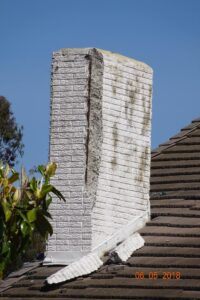 exterior chimney structure. They appear along where the reinforcement (rebar) steel is located within the structure. These cracks are not subject to patching and eventually, the chimney will lose its structural integrity.
exterior chimney structure. They appear along where the reinforcement (rebar) steel is located within the structure. These cracks are not subject to patching and eventually, the chimney will lose its structural integrity.
We are now finding that the cracks are becoming so long, deep and wide, that the chimney is literally falling apart. In this case, we recommend tearing down the entire chimney in order to avoid damage or injury due to falling concrete.
Damaged Flue Lining
The third issue that we are finding with some Rampart General Pre-Cast systems
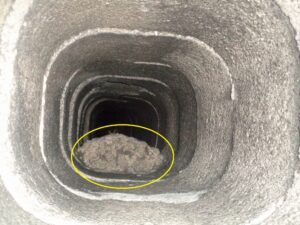
here in San Diego is that the flue lining can be damaged or cracked. The flue lining is the passageway inside the chimney structure.
Since the chimney was constructed horizontally in a cast or mold, sometimes the cast failed to contain the concrete during the construction process, and “blew out” the flue tile. This creates a concrete blob inside the flue lining which makes the fireplace system completely unusable.
Because the system cannot be relined nor a stove insert installed, the chimney can no longer be used.
Repairing a Rampart General Pre-Cast System
According to Rampart General, the manufacturer, systems with cracked insulation plates are not subject to patching.
There are some chimney companies that are using Thermocrete, a ceramic coating, to cover over the cracked insulation plate. I contacted Approved Industries, the manufacturer of Thermocrete, to find out if their product can be used for this purpose. Approved Industries stated emphatically that Thermocrete CANNOT be used for damaged insulation plates in Rampart General Pre-Cast systems. Thermocrete is not U.L. approved for this repair as well as the Rampart General system has no U.L. listing for Thermocrete as a repair. As stated above, no repairs have been approved by Rampart General, nor by the Superior and Municipal Courts of California who have made rulings in cases involving these chimney systems.
Do not allow anyone to talk you into any repairs of these conditions or resolve the problem by installing a stove insert into the chimney. This could result in a potentially dangerous fire and, since the chimney system was modified against the U.L. listing, there is a possibility that your insurance company would not honor a claim for any resulting fire to your home.
In conclusion….
Whenever you purchase a home, always have a separate Level 2 Chimney Inspection. To find a qualified chimney sweep, go through the Chimney Safety Institute of America. If you are buying a home with a Rampart General Pre-cast system, the question to ask your home inspector or chimney professional is if they have been specifically trained in these chimney systems by Dale Feb, the leading expert in the country on Ramparts. Not all home inspectors and not all chimney professionals have this specific training and therefore will not know about these systems.
For further information, please refer to Dale Feb of Fireplace Investigation, Research & Education (F.I.R.E) Services. Here is a link to his extremely well written and in-depth publication about Rampart General precast systems.


were these only installed in California?
Jim, that’s a great question. When I was first trained and educated on these systems about 15 years ago, I was under the impression that Rampart Generals were limited to California. Specifically Southern California. But since our website and blog posts about these systems have become more visible on the internet, I’ve received phone calls from as far as Virginia and New York.
Because Rampart General is no longer in business, unfortunately there’s no telling exactly how many states they’re located.
I have one of these on my bank owned home. My first home I bought in 91 is across the street and I bought it new from Ira Norris (INCO Homes) also defunct. I have the manual they supplied with the home and it is a Rampart General. Mine is a light grey material. It was painted, but the paint was flaking off in sheets. I’m repainting it to protect it. I’ve never used it and I didn’t use my original one after the first winter. My question is what can be done to the space. Do I hire a mason to construct a new fireplace and chimney or stick build a chimney and use a zero clearance fire kit? Also, how would I go about removing this beast? Thanks for any ideas!
If you’re not going to use the system and there’s no signs of external cracking, then I would just leave it there. Removing a Rampart is extremely expensive because of the cost of demolition (since it’s solid concrete) and dumping fees since that system weighs several tons.
If you choose to remove the Rampart chimney structure, then you have to do major repairs to the roof, eves, exterior stucco of the home, filling in the hole where the firebox was, and then in the interior, you’ll have to fill in the hole, take out the hearth extension, re-stucco the walls and do new flooring. This can amount to many tens of thousands of dollars. If you want to replace the Rampart, you must remove the Rampart system entirely and then either build a masonry chimney or install a prefab system. Again, many tens of thousands of dollars.
My advice: If you’re not planning on using the system, then just leave it alone, unless it has cracks in the external chimney in which case you will need to take it down before it falls down.
If you choose to remove it, I would advise contacting a local chimney professional who has had specific training in Rampart General Pre-Cast systems and who has experience at removing these systems.
Could you install a direct vent gas fireplace into a Rampart Chimney that has a cracked insulation plate? It would seem like direct venting to the outside without use of the chimney would solve the problem.
Unfortunately, any stove appliance, whether it be an insert or direct vent, is not a viable solution due to the UL listing on the appliance as well as the UL listing on the Rampart General Pre-Cast Chimney.
Any stove insert or direct vent appliance has to be tested and listed through the Underwriters Laboratories. These tests determine that the products meet certain defined requirements for public safety. The Rampart General Pre-Cast Chimney has also been tested and listed through the Underwriters Laboratories. Each listing–the one on the appliance and the one on the chimney–has to be tested for each other.
As an example, the appliance may be UL listed to be installed in a Rampart General Pre-Cast system (although I don’t know of any that are). In that case, the listing goes one way. But the Rampart General must also have been tested and listed to allow the specific manufacturer and model appliance to be installed. The U.L. listing has to go BOTH ways.
Rampart General chimneys have not been UL tested and listed to allow any stove insert or direct vent appliances to be installed.
Rampart General, the manufacturer of the pre-cast chimney, is no longer in business and cannot test the chimney to obtain a listing.
Going against the listing by installing an appliance into a Rampart General Pre-Cast system, will void out the U.L. listing on the appliance. This may mean a major liability issue for the installer if there should be a “fire event.”
No legitimate, knowledgeable and ethical stove installer or fireplace store who knows what they’re doing would install any kind of appliance into a Rampart General Pre-Cast system, ESPECIALLY if the pre-cast system is compromised by a cracked insulation plate.
Long story short, you cannot install any appliance in a Rampart General Pre-Cast system.
Would you be safe burning a decorative candle display in a Rampart Fireplace that has a cracked insulation plate?
It’s not a good idea for two main reasons: 1) Heat opens up the crack in the insulation plate. Even if it appears to be a hairline crack when it’s cold, the crack will widen up when heated up. Candles produce heat. That heat can come into contact with a combustible material; 2) I find that people who put real candles on a fireplace candelabra get very annoyed with the waxy mess that the melted candles leave on the firebox floor. Yes, there’s a specific candelabra for use with fireplaces. Check them out on Amazon.
For those reasons, why not use electronic candles on a fireplace candelabra which turn on and off automatically for 5 hours a day? You won’t risk the heat AND you won’t make a mess and it makes it so that you won’t just have an empty firebox.
I hope this helps you.
In escrow now on a home with one of these. Hope it will not cost too much to replace!
Here in San Diego, prices to remove and replace a Rampart General Pre-Cast system run around $40,000. I would HIGHLY recommend that you have a chimney expert who has had SPECIFIC TRAINING in this type of system to inspect the chimney during the inspection period. You want to make sure that they have had training by Dale Feb, the leading expert in the country for this type of system. You don’t want to find out after you have already bought the home.
In escrow on a home now in SD that has this chimney (3 of them actually…ughhhh).
I will definitely have them properly inspected. You said that 60% of them inspected have cracked insulation plates. That means 40% don’t. If it is inspected by a qualified professional and determined to be not cracked, does that mean we would be good to use it? Is this something that can happen to it in the future, or were any defects a result of manufacturing, transporting, and installing?
The City of Los Angeles has approved repairs using Thermocrete. I have heard pros and cons using Thermocrete. I have taken Dale Feb’s courses and I understand his point.
However, I have a question… or a statement; the builder’s of the Brooklyn Bridge are no longer alive, but yet the bridge is repaired frequently. Why can’t the Rampart be repaired… within reason?
I have seen Rampart chimneys that are so cracked and split that it doesn’t appear to be repairable due to substantial integrity issues.
8-29-2008
GENERAL APPROVAL – Renewal – Thermocrete Ceramic Flue Sealant (CFS) for repairing or restoration of smoke chambers and flue systems of existing code-complying masonry and precast concrete chimney.
Jan 8, 2018 From Oliver Twist.
Thermocrete Is An Approved Solution.
We get many calls every week wanting quotes for a tear down and replacement because they have been told that is the only option when cracks have been found. Not true! Thermocrete CFS Ceramic Flue Sealant has been approved for repair of “Rampart General” pre-cast and other concrete pre-cast fireplaces (per Los Angeles Research Report #25455). It can also be used to repair masonry fireplaces (visit thermocrete.com) This is huge, no more is tearing down entire chimney tear downs because there is a crack in the insulation breast plate. No more surprise, it is going to cost $25,000+ to replace the fireplace with a new pre-fab and don’t forget to pull all the permits.
I have a property in escrow where the buyer wants us to tear the whole chimney down. I am curious to know more about this Thermocrete CFS Ceramic